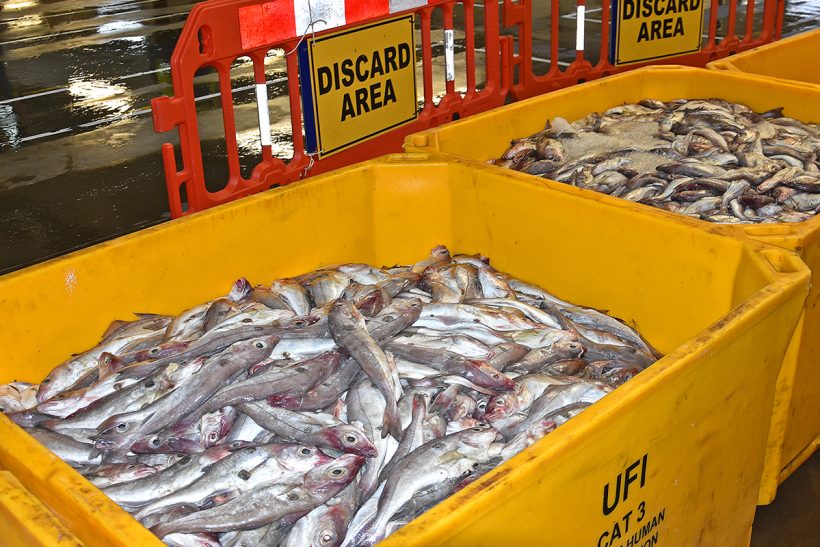End of ‘education’ phase of discards ban
The MMO will be taking a tougher line on enforcing the landing obligation/discards ban next year, after a period of educating fishermen on the requirements of the rules, reports Tim Oliver
DEFRA official Andrew Newlands told a recent meeting of the Seafish Discards Action Group – now renamed the Fisheries Management and Innovation Group (FMIG) – that during the phasing-in period of the discards ban, much of 2018 and the early months of 2019 had been focused on ensuring that fishermen had the right information to be able to comply with the new requirements.
He said: “Following this initial period of education, in English waters the MMO is now moving towards a more enforcement-centred approach – where control and enforcement efforts will be increased to identify non-compliance and to improve the accuracy of catch recording, particularly in high-risk fisheries.”
This enforcement-centred approach includes:
- Recording the last-hauled catch on vessels to assess the catch profile (rather than only what has been retained onboard)
- Increasing the number of inspections of landings and at sea
- Rolling out the under-10m catch-reporting system
- Introducing inshore vessel monitoring systems
- Increasing the scientific evidence base of the state of the stocks.
He said that through its contact with the industry, and from the MMO’s data on discarding activity, DEFRA was seeing increased engagement with the requirements of the landing obligation, and believed greater efforts were being made to comply.
For example, the market for stocks below minimum conservation reference size (MCRS) was slowly growing, such as for pot bait, and infrastructure changes were being made, with storage bins being increasingly installed at landing ports and harbours.
DEFRA and the MMO are currently exploring the potential use of remote electronic monitoring (REM) using onboard CCTV cameras, alongside other monitoring and enforcement tools, as a cost-effective and efficient way of monitoring fishing activity and ensuring compliance.
Some trials of REM have already been undertaken, and have reduced discarding rates ‘significantly’ – for example, in a number of fisheries throughout the UK since 2011, and in the English North Sea as part of a fully documented fisheries (FDF) scheme, managed by the MMO.
NFFO chief executive Barrie Deas, who gave a roundup of where the discards ban stands in 2019, said there were two schools of thought on enforcing the policy.
One was that the discards ban could not be simply imposed by heavy policing, and that it required ‘a major cultural shift’ in attitudes if it was to work. It was an ‘extremely complex’ issue, and the authorities would need to work in collaboration with the industry to address the issues involved. Within this view, REM had a role to play, but not as a ‘top-down’ heavy-handed control mechanism.
An alternative view was that CCTV onboard vessels was a ‘panacea’ that would resolve the enforcement problem – but in reality, there were legal, ethical and practical issues associated with enforcing mandatory use of cameras.
He said that progress had been made on co-working with the formation of the Landing Obligation Forum by DEFRA/MMO/NFFO/UKAFPO, which enabled dialogue between the regulators and the regulated, and fostered co-ownership of the problems and co-management.
He warned of a critical period ahead, with the proposed heavy cut in the 2020 North Sea cod TAC, and the Commission’s rigid adherence to cutting TACs to achieve MSY by 2020, creating major choke risks in mixed fisheries next year.
He also warned of the danger that continued illicit discarding, in fisheries where there was extra quota allocated on the basis that there would be no discards, would lead to an increase in fishing mortality, and thus to lower TACs.
He said that the industry hoped that the new fisheries bill after Brexit would give scope for a more workable discards ban.
Seafish gear technologist Mike Montgomerie described the latest selective gears that had been approved in 2019 by the MMO, Marine Scotland, and DAERA in Northern Ireland, to give fishermen more options to help them meet the demands of the landing obligation. He said that the EU revised technical conservation regulations will also give fishermen more options to improve selectivity.
The new approved gears he described included the benthos release panel, flip-up rope, Flemish panel, CEFAS net grid, net grid selectivity device, Seltra flip-flap trawl, Sep Nep, Eliminator trawl, and square mesh panels.
Barrie Deas said that there had been a general increase in selectivity over the past 20 years, and that fish below MCRS were not a major feature of catches.
He said that mandatory selective measures that reduced fishermen’s marketable catch ‘rarely deliver’, and that it was ‘the mindset in the wheelhouse’ that mattered. Improving gear selectivity was ‘a never-ending quest’, and the use of light to direct fish in nets was ‘the next frontier’.
Paul Macdonald of the Scottish Fishermen’s Organisation gave a detailed description of the development in Scotland of a real-time software system to report cod and whiting catches, and enable skippers to avoid areas of high concentration (Fishing News, 21 November, ‘High-tech approach to cod avoidance’).
Scottish fishermen and scientists are collaborating to develop the system, which will be trialled on the west coast of Scotland up to the end of 2020. It follows the EU’s zero-catch advice for cod and whiting on the west coast, where fishermen need to keep fishing for healthy stocks such as haddock and monkfish.
A small by-catch allowance has been set up in this and other zero-catch fisheries, but skippers still need to avoid cod and whiting so they do not choke the fishery under the discards ban.






